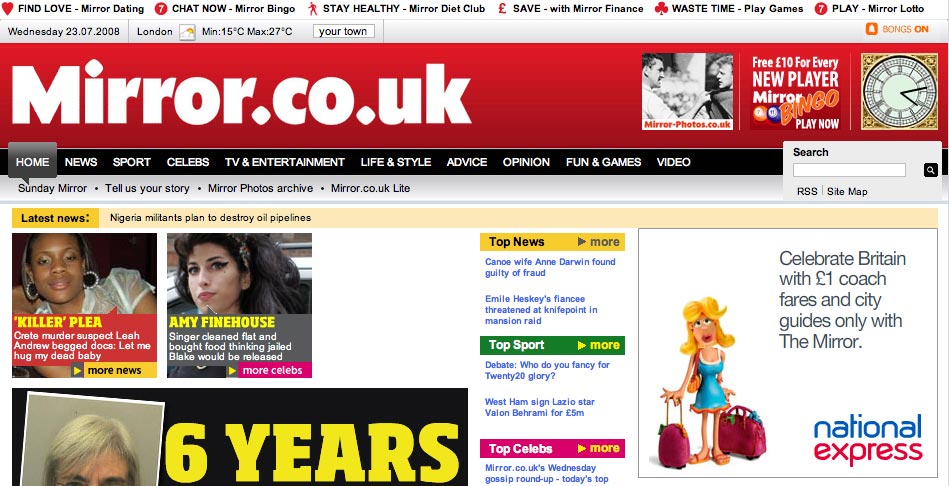We love a list here at Journalism.co.uk – here’s 10,000 Words’ guide to why ’50 million-word stories’ and ‘no links whatsoever’ don’t work for online news sites.
Tag Archives: Design
Mirror.co.uk joins competitors with homepage redesign
Not wanting to be left out following a new look for The Sun’s homepage last Friday, a Telegraph.co.uk redesign and the last stage of the Guardian’s site revamp, Mirror.co.uk began its relaunch on Monday.
Starting with changes to the homepage, the rest of the site will follow suit and new features will be introduced in the coming weeks, an announcement on the site said.
On the homepage a most read/most emailed/highest rated articles box has been added and the left-hand navigation bar done away with. Links to Mirror.co.uk subscription services are neatly lined up across the top of the homepage.

Elsewhere the site’s video player has been upgraded (though the ‘see more videos’ tab opens up another window still), more picture galleries added and the blogs section overhauled with some new additions.

So how does this first stage of redevelopment compare with its competitor’s new looks?
It’s certainly colourful with the addition of multicoloured section headings and if you navigate better with images than this is for you – though personally I find the block of images that dominate the ‘above the fold’ area a tad too busy.
More embedded video, which seems to be happening across the article pages, is a plus, as is the vastly improved ‘below the fold’ on the homepage, which has been tidied up no end.
Independent: Harold Evans on newspaper design
Colour should be used with caution, says the former Sunday Times editor.
Black and white photos and text are too often neglected, says Evans, who adds that good design has the potential to ‘sustain’ newspapers.
Telegraph.co.uk redesign: engagement above traffic?
Speaking at yesterday’s preview of the Telegraph.co.uk redesign, both chief information officer Paul Cheesbrough and digital editor Edward Roussel said the new site was aimed at ‘deeper engagement’ with users.
Both declined to comment on whether the new site would bring success in terms of ABCe figures, even suggesting the amount of content/page views per user was more important at this stage than an increased numbers of visitors.
“If we have doubled the amount of content that each person is consuming [by the end of the year] then that’s great,” said Roussel.
The current average for the site is 16 page views per person per month, he added.
A raft of improvements have been made in the new design to address the issue of engagement. Firstly improved search and navigation features to help users find the content they are after more quickly and keep them on the site.
Changes to the site’s servers have also been implemented with a series of international servers set up so the experience of accessing the site is the same wherever you are, Cheesbrough explained.
These changes were made necessary after ‘power outages’ on the site last year, which brought Telegraph.co.uk down for prolonged periods. In contrast the site is now the fastest news site behind the BBC, Cheesbrough claimed.
One of the most significant changes for me – and the one which lends itself most immediately to both engagement and traffic goals – is an increase in embedded video.
Following hot on the heels of the BBC and FT, who have both made the move to embedded video, the new Telegraph.co.uk will embed its video content within articles across the site and lose the standalone Telegraph TV player box on the homepage.
The BBC’s Pete Clifton told Journalism.co.uk previously that the conversion rate – the number of people reading the text article and viewing the video footage – was around 40 per cent for embedded video and only 2 per cent when video was housed in a separate player.
Initial trials of embedding on Telegraph.co.uk have produced similarly positive results, said Cheesbrough, with a 30 per cent conversion rate for embedded videos compared to a 3 per cent rate for Telegraph TV.
It’s a logical progression that boosts views and keeps the user engaged for longer, and is part of what the team behind the Telegraph redesign refer to as ‘the concept of the article as the homepage’.
This shows an awareness that the homepage is no longer the main point of entry – around half of the site’s traffic comes through aggregators. Putting as much effort into the design and accessibiilty of every page of your site, as most publications put into their homepage, could well be a winning strategy for both traffic and engagement.
NYTimes innovation plans: Widgets, iPhone, APIs
Silicon Valley Insider talked to Marc Frons, chief technology officer of NYTimes digital, about the projects he’s working on and the development that they’ll be rolling out in the near future. Here’s a brief overview:
Things we have already covered:
- Those APIs: the plan is to eventually let developers outside of the Times play with its content and create new sites or services.
- Times People: expect more development so it’s not just a browser plug-in.
The shock of the new:
- Widgets: Customisable box of Times stories, video, slideshows and the rest on your blog or social network page? Yes please.
- Aggregation: It bought Blogrunner an eternity ago and uses it now just to pull content from partner sites into NYTimes – think PaidContent, CNET stuff on the Tech pages. But ‘bigger plans’ are afoot – Frons won’t say more though.
- Apps: Yes, NYTimes.com is working on apps for Apple’s forthcoming iPhone store.
South Africa’s Mail & Guardian newspaper unveils new all singing, all dancing website
South Africa’s Mail & Guardian newspaper has substantially revamped its website, in the process introducing a series of new features to improve usability.
M&G Online’s general manager Matthew Buckland blogged recently about the use of Thompson Reuters Open Calais semantic tagging technology to organise and cross-reference all the site’s content for the relaunch.
In addition to this the revamp has introduced a number of key features:
Registration and dashboard
- Like the Guardian in the UK, the new M&G site now allows users to save clippings of favourite articles and story history while browsing.
- Comment on articles and debate with other readers
New features
- It has also introduced a topics A-Z: A list of people, places, subjects and organisations covered by the site
- Added a feature – NewsSwarm – that allows users to see who is viewing which article in real time
- Integrated articles with Google Maps
- Make the popular cartoon sections searchable and tagged
- Added easy exploration of e-commerce areas: jobs, cars, dating, property and shopping
- Allowed users to view related articles from outside the news website.
- Added video feeds
Semantic tagging – a key new element
- Tag clouds of subjects, people and places on the home page and news sections
- Articles regionally organised and can be viewed by country or city with South African news at town, city or provincial level
- Articles are also tagged with names of cities, countries, companies or organisations, and people, which can be viewed in the Topics A-Z section
NYTimes.com: Q&A with Khoi Vinh, design director for NYTimes.com
Vinh answers readers questions on what it takes to work for the newsroom of NYTimes.com and the design details of the online edition.
In the feature, Vinh admits the paper looks to other news websites for inspiration and gives Guardian.co.uk in particular.
“We draw inspiration from what’s happening in digital media at large, regardless of whether or not a news organization is explicitly involved,” adds Vinh.
Paid Content: WSJ.com to undergo major redesign
WSJ.com will undergo a vast site redesign and relaunch in the coming months, so says Paid Content.
The overhaul will spread across the site section by section (a la Guardian.co.uk revamp), says the report, with some elements already being rolled out now on the site – check the changes to media & marketing.
New sections will also appear. PC points to the extended coverage of sport on the site.
Online Journalism Scandinavia: Norway’s leading news sites strategies for attracting online audience
 Kristine Lowe is a freelance journalist who writes on the media industry for number of US, UK and Norwegian publications. This week Online Journalism Scandinavia looks at how Norway’s leading news sites attract their audiences. Continue reading
Kristine Lowe is a freelance journalist who writes on the media industry for number of US, UK and Norwegian publications. This week Online Journalism Scandinavia looks at how Norway’s leading news sites attract their audiences. Continue reading
Come hither, cutting-edge news site designers…
…We want to hear from you. Designing search-engine friendly, fast-loading websites that meet best practice for accessibility, adhere to all the latest standards and display consistently across the widest possible range of browsers without awkward hacks is tricky enough. Creating sites that also meet the multi-faceted demands of a news organisation is a higher order of challenge altogether.
But we know you are out there. Whether you be design agencies, or lone guns, get in touch and tell us about your success stories. If you impress us and we think you will impress our readers, we will showcase your work on Journalism.co.uk. Hell, we might even hire you…
Drop me an email – john (at) journalism.co.uk or leave a comment.